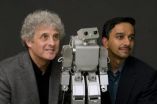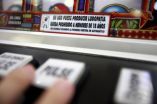(Press-News.org)
AUDIO:
When a person has a heart attack, and the heart stops beating, a new study led by researchers at Washington University School of Medicine in St. Louis suggests that the...
Click here for more information.
Heart attack patients whose hearts have stopped beating and who receive cardiopulmonary resuscitation (CPR) from bystanders fare better if their resuscitators skip the rescue breaths and do only chest compression, according to a study led by researchers at Washington University School of Medicine in St. Louis.
The study, published online on Oct. 15 in The Lancet, determined that the chest compression-only method of CPR improved survival rates over standard CPR.
Standard CPR involves alternating chest compressions with rescue breaths.
"We looked at data from three studies," says principal investigator Peter Nagele, MD. "Individually, the studies were 'underpowered' statistically and could not show a survival benefit. Basically, there were too few study subjects to determine whether one method of CPR improved survival more than another, but when we combined all three studies, there was a significant increase in survival when witnesses were told by 911 dispatchers to provide chest compression only."
Nagele, an assistant professor of anesthesiology and chief of trauma anesthesiology at Barnes-Jewish Hospital in St. Louis, and his team combined the data from the three studies in a meta-analysis and were able to analyze survival rates in more than 3,700 cardiac arrest patients who received either standard CPR or chest compression only. Those smaller studies had suggested chest compression-only CPR may improve survival – one noted a 14 percent increased survival to hospital discharge, while a second reported a 24 percent improvement in 30-day survival – but because of relatively small numbers in those studies, it was impossible to conclusively determine which of the two CPR methods was actually better.
But analyzing all three studies, Nagele's team determined that survival improved by 22 percent when bystanders called 911 and were advised by the dispatcher to do chest compression-only CPR.
"When a person goes into cardiac arrest because of a problem with the heart, that individual normally has plenty of oxygen in the body," Nagele explains. "So rescue breaths aren't as vital to survival as trying to keep blood flowing as regularly as possible. However, if cardiac arrest is secondary to trauma, drowning or a problem not directly related to heart function, then it is advisable to do standard CPR that includes rescue breaths. In those cases, getting oxygen into the system is crucial."
The findings do not apply to children with cardiac arrest, Nagele stresses.
"It is very uncommon for kids to go into cardiac arrest due to a primary heart problem," Nagele says. "If cardiac arrest does occur, it's likely to be secondary to a severe asthma attack, an allergic reaction or something else unrelated to the heart. Under those circumstances, the body needs oxygen. I strongly recommend chest compression and rescue breaths in kids."
Whether a bystander had previous training in CPR had no effect on patient survival in this study. When emergency dispatchers recommend only chest compression, it is relatively easy for a bystander to find the proper area of the chest, begin doing compressions and keep going until emergency medical technicians arrive, Nagele says.
Part of the reason earlier studies could not verify a statistical benefit from the chest-compression-only technique was that the patient survival rate hovers around 10 percent. Even with 1,000 or 2,000 patients in a study, the total number of survivors was small. Only by combining data from all three studies to generate larger numbers were the investigators able to confirm improved survival.
The research team, which included investigators from the Medical University of Vienna in Austria, determined that a 20 percent improvement in survival related to chest compression-only CPR in cardiac arrest patients in North America and the European Union could save as many as 5,000 to 10,000 lives each year.
The new study also found that the benefit occurred only when 911 dispatchers coached bystanders to use chest compression-only CPR. In several uncontrolled studies that simply asked bystanders whether they did only chest compressions or standard CPR, the investigators found no survival benefit with the chest compression-only technique.
Nagele says his findings suggest that if someone nearby has a heart attack, it's important to first call 911, and then begin chest compressions. He says if it takes several minutes for help to arrive, it also may become necessary to begin rescue breaths, but for the first five to 10 minutes, chest compressions are more important.
"The heart doesn't literally stop during cardiac arrest," he says. "It gets super excited and electrically very active, and the only way to get it back into rhythm is with an electrical shock, a defibrillation. By doing chest compression-only CPR, a bystander is basically buying time until a paramedic with a defibrillator can jump-start the heart."
INFORMATION:
Hupfi M, Selig HF, Nagele P. Chest compression-only CPR: a meta-analysis. The Lancet vol. 376 (9749), published online Oct. 15, 2010. www.thelancet.com.
This work was supported by grants from the American Heart Association and the National Institutes of Health.
Washington University School of Medicine's 2,100 employed and volunteer faculty physicians also are the medical staff of Barnes-Jewish and St. Louis Children's hospitals. The School of Medicine is one of the leading medical research, teaching and patient care institutions in the nation, currently ranked fourth in the nation by U.S. News & World Report. Through its affiliations with Barnes-Jewish and St. Louis Children's hospitals, the School of Medicine is linked to BJC HealthCare.
Chest compression-only CPR improves survival in cardiac arrest patients
2010-10-15
ELSE PRESS RELEASES FROM THIS DATE:
Scientists find signals that make cell nucleus blow up like a balloon
2010-10-15
Size matters when it comes to the nucleus of a cell, and now scientists have discovered the signals that control how big the nucleus gets.
Nuclear size varies not only among different species, but also in different types of cells in the same species and at different times during development. In addition, cancer cells are known to develop larger nuclei as they become more malignant. Screening for cervical cancer, for example, involves looking for grossly distorted nuclei in cervical cells collected during a Pap smear.
"Pathologists look at nuclear size in cancer cells ...
New research results change the understanding of atmospheric aerosol properties and climate effects
2010-10-15
Atmospheric fine particles affect the Earth's radiation balance by interacting with solar radiation and by participating in cloud formation. Biogenic volatile organic compounds are key players in new particle formation processes. Hence, terrestrial vegetation has an important role as the newly formed particles cool our climate. The chemical composition of such secondary organic aerosol (SOA) particles formed from volatile compounds emitted by vegetation is very complicated and only limited information on the phase state of SOA particles has been available. Thus the scientific ...
A reinvention of agriculture is needed to meet global challenges
2010-10-15
Des Moines, Iowa USA: World renowned scientists speaking at the World Food Prize Borlaug Dialogue have called for a radical transformation in the agriculture sector to cope with climate change, food security and to transition towards sustainability.
Dr Dennis Garrity, Director General of the World Agroforestry Centre and Professor MS Swaminathan, 1987 World Food Prize Laureate and founder of the MS Swaminathan Research Foundation, have teamed up to promote what they call a 'fresh out of the box solution' which is already dramatically improving crop yields while storing ...
I want to see what you see: Babies treat 'social robots' as sentient beings
2010-10-15
Babies are curious about nearly everything, and they're especially interested in what their adult companions are doing. Touch your tummy, they'll touch their own tummies. Wave your hands in the air, they'll wave their own hands. Turn your head to look at a toy, they'll follow your eyes to see what's so exciting.
Curiosity drives their learning. At 18 months old, babies are intensely curious about what makes humans tick. A team of University of Washington researchers is studying how infants tell which entities are "psychological agents" that can think and feel.
Research ...
Key to blood-brain barrier opens way for treating Alzheimer's and stroke
2010-10-15
While the blood-brain barrier (BBB) protects the brain from harmful chemicals occurring naturally in the blood, it also obstructs the transport of drugs to the brain. In an article in Nature scientists at the Swedish medical university Karolinska Institutet now present a potential solution to the problem. The key to the BBB is a cell-type in the blood vessel walls called pericytes, and the researchers hope that their findings will one day contribute to new therapies for diseases like Alzheimer's and stroke.
"Our new results show that the blood-brain barrier is regulated ...
Overseas nurses feel their skills are underused and they aren't valued or respected
2010-10-15
Many overseas nurses have negative experiences of living and working in the UK, particularly when it comes to feeling personally valued and professionally respected, according to the October issue of the Journal of Clinical Nursing.
Researchers from the University of Northampton also found that discrimination and racism still exist in the National Health Service and that the reality of first-world UK nursing is often very different to what overseas nurses expect.
Senior lecturer and nurse Julia Nichols and Professor of Neurophysiology Jackie Campbell carried out ...
Scientists perfect new nanowire technique
2010-10-15
Scientists at the University of Leeds have perfected a new technique that allows them to make molecular nanowires out of thin strips of ring-shaped molecules known as discotic liquid crystals (DLCs).
The findings could be an important step in the development of next generation electronic devices, such as light-harvesting cells and low-cost biosensors that could be used to test water quality in developing countries.
DLCs are disk-shaped molecules that are one of the more promising candidates for organic electronic devices. However, controlling their alignment has proved ...
4 kinds of compulsive gamblers identified
2010-10-15
Disorganised and emotionally unstable, poorly adapted, suffering from alcohol problems, impulsive, or with a "globally adapted" personality. These are the features of the four diagnosed types of compulsive gamblers identified by researchers at the University Hospital of Bellvitge (IDIBELL) and the Autonomous University of Barcelona (UAB). According to the scientific team, only one of these four shows signs of a significant pathology.
"We need to use different treatments for each sub-group of pathological gamblers in order to respond to their specific therapeutic difficulties ...
New malware could steal users social media behavior and info -- Ben-Gurion U. researchers
2010-10-15
BEER-SHEVA, ISRAEL, October 14, 2010 -- A new study by Ben-Gurion University of the Negev (BGU) researchers predicts that a new generation of malware (software written for malicious purposes like identity theft) could steal data on human behavior patterns, which is more dangerous than traditional, detectable attacks.
In the newly published paper, "Stealing Reality," Dr. Yaniv Altschuler and Dr. Yuval Elovici from BGU discuss malware threats that extract personal information about relationships in a real-world social network, as well as characteristic information about ...
New method is found for accurate diagnosis of gall bladder cancer, 1 of the most deadly
2010-10-15
Researchers a the University of Granada and the Department of Nuclear Medicine, Hospital Virgen de las Nieves at Granada found that the metabolic imaging diagnosis technique –based on the analysis of a structural analog of glucose labeled with a positron-emitting compound (18F)– allows early diagnosis of gall bladder cancer, a relatively rare disease with high mortality rates among most patients suffering from it.
For the purpose of this study, 62 patients were subjected to this scanning method, which represents the largest sample of patients with gall bladder cancer ...




